
In the 11th day of Sam Bankman-Fried’s criminal trial, the prosecution brought out an accountant.
University of Notre Dame Professor Peter Easton, a forensic accountant, was called to the witness stand on Wednesday (Oct. 18) to detail to the jury what, in his analysis, exactly happened to the around $9 billion in FTX customer funds that went missing before the cryptocurrency exchange filed for bankruptcy in November 2022.
Asked by the government’s prosecution team what his area of research was, Easton replied “penetrating the details of financial statements.”
Asked whether the financial statements of Alameda Research and FTX showed the use of customer funds, Easton replied, “Oh yes.”
After days of somewhat salacious personal testimony from the government’s star insider witnesses, including Gary Wang, the FTX co-founder and CTO; Alameda CEO Caroline Ellison; and FTX engineering director Nishad Singh; Easton’s detailed financial presentations had some members of the jury clutching their heads.
But while Bankman-Fried may have lied, the numbers Easton analyzed didn’t. The university professor testified that for more than full calendar year before its eventual collapse, FTX’s prolific spending had put the company in a position where it was unable to meet customer deposits.
Read also: New Criminal Charges Allege Bankman-Fried Used FTX Funds as Personal Piggy Bank
Bankman-Fried, FTX’s founder and ex-CEO turned accused criminal fraudster, has repeatedly blamed both his own shortfalls and his crypto empire’s failure on accounting errors and a general lack of oversight, not the misappropriation and subsequent loss of billions of FTX customer funds.
While other FTX and Alameda executives have flipped on Bankman-Fried, pleaded guilty themselves, and are cooperating with federal prosecutors, the 31-year-old alone has maintained his innocence in the face of the seven counts he is being prosecuted for.
Easton, whom the government is paying for his services, analyzed the FTX Group’s bank statements, loan documents, cryptocurrency holdings and exchange accounts and testified on Wednesday about many instances where, per his analysis, flows of funds led back to FTX deposits as their source.
The firm’s liabilities were more than its cash on hand going back to at least the first quarter of 2021, he testified, and the largest discrepancy was in June 2022, when FTX was supposed to hold $11.3 billion of customer funds, but in reality only had $2.3 billion on hand in its bank accounts.
Read also: Physics of the FTX Bubble: Hot Air Rises Fastest
When asked on many occasions about the source of funds for investments and payments made by FTX and Alameda, Easton replied “customers.”
“What about the Binance share buy-back?” prosecutors asked.
“Over a billion dollars came from customer funds from FTX exchange,” Easton testified.
“Lenders Celsius, Abra, Maple, Anchorage?” prosecutors asked.
“All from customer funds,” Easton testified.
“Modulo Capital?”
“Customer funds,” Easton said.
He also told the jury that some, not all, of FTX’s 30% stake in Anthony Scaramucci’s Skybridge Capital came from misappropriated customer money.
Modulo Capital returned the hundreds of millions of dollars last March.
Read also: Sam Bankman-Fried, FTX and the Demise of the Cool Kids
While Easton’s analysis gave examples of donations made, ventures invested in, and real estate purchased during times when the FTX enterprise did not have enough funds on hand to cover their cost, he also presented examples where FTX could have used its own money.
Overall, the professor’s testimony contended that there was consistently much less fiat currency on hand at FTX than the exchange owed to its customers, the exchange held much less cryptocurrency assets than had been deposited by its customers, and that the FTX group of companies used both deposited fiat currency and customer cryptocurrency to support its own spending.
The government witness also demonstrated to the court that had Alameda actually went ahead and used all the funds available for spot margin trading on FTX, this still wouldn’t have been enough to cover the company’s liabilities to its customers.
Asked whether he had found all of the accounts with the infamous “Allow_Negative” feature, Easton replied that he had — and that they all belonged to Alameda.
The government expects to rest its case a week from Thursday (Oct. 19). A former FTX attorney, Can Sun, will be among their next witnesses.
It remains to be seen who, if any one at all, the defense will call to the witness stand when they present their case.